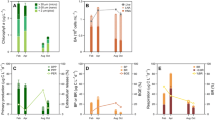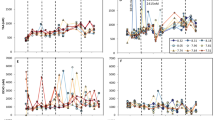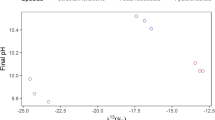Abstract
Extracellular enzymatic activities (EEAs) are the rate-limiting step in the degradation of organic matter. Extracellular enzymes can be found associated to cells or dissolved in the surrounding water. The proportion of cell-free EEA constitutes in many marine environments more than half of the total activity. This high proportion causes an uncoupling between hydrolysis rates and the actual bacterial activity. However, we do not know what factors control the proportion of dissolved relative to total EEA, nor how this may change in the future ocean. To resolve this, we performed laboratory experiments with water from the Great Barrier Reef (Australia) to study the effects of temperature and dissolved organic matter sources on EEA and the proportion of dissolved EEA. We found that warming increases the rates of organic matter hydrolysis and reduces the proportion of dissolved relative to total EEA. This suggests a potential increase of the coupling between organic matter hydrolysis and heterotrophic activities with increasing ocean temperatures, although strongly dependent on the organic matter substrates available. Our study suggests that local differences in the organic matter composition in tropical coastal ecosystems will strongly affect the proportion of dissolved EEA in response to ocean warming.



Similar content being viewed by others
References
Albertson NH, Nystrom T, Kjelleberg S (1990) Macromolecular-synthesis during recovery of the marine Vibrio sp. S14 from starvation. J Gen Microbiol 136:2201–2207
Alderkamp AC, Mv Rijssel, Bolhuis H (2007) Characterization of marine bacteria and the activity of their enzyme systems involved in degradation of the algal storage glucan laminarin. FEMS Microbiol Ecol 59:108–117
Allison SD, Chao Y, Farrara JD, Hatosy S, Martiny A (2012) Fine-scale temporal variation in marine extracellular enzymes of coastal southern California. Front Microbiol 3:301
Amon RMW, Benner R (1996) Bacterial utilization of different size classes of dissolved organic matter. Limnol Oceanogr 41:41–51
Arnosti C (2011) Microbial extracellular enzymes and the marine carbon cycle. Annu Rev Mar Sci 3:401–425
Azam F, Cho BC (1987) Bacterial utilization of organic matter in the sea. Ecology of microbial communities. Cambridge University Press, Cambridge, pp 261–281
Baltar F, Sintes E, Van Aken H, Gasol JM, Arístegui J, Herndl GJ (2009) Prokaryotic extracellular enzymatic activity in relation to biomass production and respiration in the meso- and bathypelagic waters of the (sub)tropical Atlantic. Environ Microbiol 11(8):1998–2014
Baltar F, Arístegui J, Gasol JM, Sintes E, van Aken HM, Herndl GJ (2010) High dissolved extracellular enzymatic activity in the deep central Atlantic Ocean. Aquat Microb Ecol 58:287–302
Baltar F, Arístegui J, Gasol JM, Yokokawa T, Herndl GJ (2013) Bacterial versus archaeal origin of extracellular enzymatic activity in the Northeast Atlantic deep waters. Microb Ecol 65(2):277–288
Baltar F, Legrand C, Pinhassi J (2016a) Cell-free extracellular enzymatic activity is linked to seasonal temperature changes: a case study in the Baltic Sea. Biogeosciences 13(9):2815–2821
Baltar F, Lundin D, Palovaara J, Lekunberri I, Reinthaler T, Herndl GJ, Pinhassi J (2016b) Prokaryotic responses to ammonium and organic carbon reveal alternative CO2 fixation pathways and importance of alkaline phosphatase in the mesopelagic North Atlantic. Front Microbiol 7:1670
Benner R, Amon RM (2015) The size-reactivity continuum of major bioelements in the ocean. Annu Rev Mar Sci 7:185–205
Bevington PR, Robinson DK (2003) Data reduction and error analysis for the physical sciences. McGraw Hill, San Francisco
Bochdansky AB, Puskaric S, Herndl GJ (1995) Influence of zooplankton grazing on free dissolved enzymes in the sea. Mar Ecol Prog Ser 121:53–63
Chrost RJ (1991) Environmental control of the synthesis and activity of aquatic microbial ectoenzymes. Microbial enzymes in aquatic environments. Brock/springer series on contemprorary bioscience. Springer, New York, pp 29–59
Chrost RJ, Rai H (1993) Ectoenzyme activity and bacterial secondary production in nutrient-improverished and nutrient-enriched mesocosms. Microb Ecol 25:131–150
Collins M, Knutti R, Arblaster J, Dufresne J-L, Fichefet T, Friedlingstein P, Gao X, Gutowski W, Johns T, Krinner G (2013) Long-term climate change: projections, commitments and irreversibility. In: T.F. Stocker DQ, G.-K.Plattner, M. Tignor, S. K. Allen, J. Boschung, A. Nauels, Y. Xia, V. Bex, and P.M. Midgley (ed) Climate change 2013, The physical science basis. Contribution of working group I to the fifth assessment report of the intergovernmental panel on climate change. Cambridge University Press, NewYork, p 1029–1136
Duarte CM (2017) Reviews and syntheses: hidden Forests, the role of vegetated coastal habitats on the ocean carbon budget. Biogeoscience 14:301–310
Duhamel S, Dyhrman ST, Karl DM (2010) Alkaline phosphatase activity and regulation in the North Pacific Subtropical Gyre. Limnol Oceanogr 55(3):1414–1425
Hollibaugh JT, Azam F (1983) Microbial degradation of dissolved proteins in seawater. Limnol Oceanogr 28:1104–1116
Hoppe H-G (1983) Significance of exoenzymatic activities in the ecology of brackish water: measurements by means of methylumbelliferyl-substrates. Mar Ecol Prog Ser 11:299–308
Hoppe H (1984) Relations between bacterial extracellular enzyme activities and heterotrophic substrate uptake in a brackishwater environment. In: 2. Colloque International de Bacteriologie Marine, Brest (France), 1–5
Hoppe H-G, Arnosti C, Herndl GJ (2002) Ecological significance of bacterial enzymes in the marine environment. In: Burns RG, Dick RP (eds) Enzymes in the environment: activity, ecology, and applications. Marcel Dekker Inc, New York, pp 73–108
Huete-Stauffer TM, Arandia-Gorostidi N, Díaz-Pérez L, Moran XAG (2015) Temperature dependences of growth rates and carrying capacities of marine bacteria depart from metabolic theoretical predictions. FEMS Microbiol Ecol 91(10):fiv111
Huete-Stauffer TM, Arandia-Gorostidi N, Alonso-Sáez L, Morán XAG (2016) Experimental warming decreases the average size and nucleic acid content of marine bacterial communities. Front Microbiol 7:730
Karner M, Herndl GJ (1992) Extracellular enzymatic activity and secondary production in free-living and marine snow associated bacteria. Mar Biol 113:341–347
Karner M, Rassoulzadegan F (1995) Extracellular enzyme activity: indications for high short-term variability in a coastal marine ecosystem. Microb Ecol 30:143–156
Keith SC, Arnosti C (2001) Extracellular enzyme activity in a river-bay-shelf transect: variations in polysaccharide hydrolysis rates with substrate and size class. Aquat Microb Ecol 24:243–253
Kim C, Nishimura Y, Nagata T (2007) High potential activity of alkaline phosphatase in the benthic nepheloid layer of a large mesotrophic lake: implications for phosphorus regeneration in oxygenated hypolimnion. Aquat Microb Ecol 49:303–311
Li H, Veldhuis MJW, Post AF (1998) Alkaline phosphatase activities among planktonic communities in the northern Red Sea. Mar Ecol Prog Ser 173:107–115
Obayashi Y, Suzuki S (2008) Adsorption of extracellular proteases in seawater onto filters during size fractionation. J Oceanogr 64:367–372
Piontek J, Haendel N, Langer G, Wohlers J, Riebesell U, Engel A (2009) Effects of rising temperature on the formation and microbial degradation of marine diatom aggregates. Aquat Microb Ecol 54:305–318
Piontek J, Lunau M, Händel N, Borchard C, Wurst M, Engel A (2010) Acidification increases microbial polysaccharide degradation in the ocean. Biogeosciences 7:1615–1624
Rego JV, Billen G, Fontigny A, Someville M (1985) Free and attached proteolytic activity in water environments. Mar Ecol Prog Ser 21:245–249
Sala MM, Karner M, Arin L, Marrasé C (2001) Measurement of ectoenzyme activities as an indication of inorganic nutrient imbalance in microbial communities. Aquat Microb Ecol 23:301–311
Smith DC, Simon M, Alldredge AL, Azam F (1992) Intense hydrolytic enzyme activity on marine aggregates and implications for rapid particle dissolution. Nature 359:139–142
Someville M, Billen G (1983) A method for determining exoproteolytic activity in natural waters. Limnol Oceanogr 28:190–193
Steen AD, Arnosti C (2011) Long lifetimes of beta-glucosidase, leucine aminopeptidase, and phosphatase in Arctic seawater. Mar Chem 123(1–4):127–132
Vetter YA, Deming JW, Jumars PA, Krieger-Brockett BB (1998) A predicitive model of bacterial foraging by means of freely released extracellular enzymes. Microb Ecol 36:75–92
Weiss M, Abele U, Weckesser J, Welte W, Schiltz E, Schulz GE (1991) Molecular architecture and electrostatic properties of bacterial porin. Science 254:1627–1630
Acknowledgements
The authors would like to thank the SeaSim team at AIMS for the help with setting up the experiments. The study was co-financed by the AIMS visiting fellowship program as part of the capability development fund (CDF). F. Baltar was supported by a University of Otago Research Grant.
Author information
Authors and Affiliations
Corresponding author
Ethics declarations
Conflict of interest
The authors declare that they have no conflict of interest.
Additional information
Responsible Editor: Leila J. Hamdan.
Rights and permissions
About this article
Cite this article
Baltar, F., Morán, X.A.G. & Lønborg, C. Warming and organic matter sources impact the proportion of dissolved to total activities in marine extracellular enzymatic rates. Biogeochemistry 133, 307–316 (2017). https://doi.org/10.1007/s10533-017-0334-9
Received:
Accepted:
Published:
Issue Date:
DOI: https://doi.org/10.1007/s10533-017-0334-9




